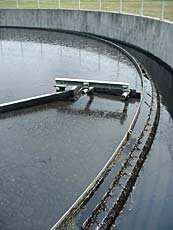|
While concern over the prison
exceeding their flow limits became a problem in July, daily
communications and collaboration have brought them back into line
with set standards. Still, the general flow through the plant
exceeds capacity on a regular basis. Bob Merreighn, facility
operator and lab technician, pointed out on the daily reports that
after a week without rain the flow through the plant was between
3.4 and 3.6 million gallons per day.
Expanded capacity and
newer, more stringent controls on wastewater treatment prompted the
need for the upgrade. The facility operation permit comes up for
renewal this fall. Operators began working on plans about a year and
a half ago in order to meet IEPA requirements for renewal.

The IEPA approved a
20-year revolving loan at 2.6 percent interest to fund the project.
The IEPA is also the final authority to approve the construction
plans. The city has chosen to work under a design-build project,
using a single source for design and implementation. Environmental
Management Corporation contracts with other firms, including an
engineering firm, Donahue and Associates, and a construction firm,
Paric Corporation.
The original facility
was built at this site in 1936. The designers foresaw the need for
expansion in the future and incorporated space in the original
plans.
The current design of
the facility, last updated in 1978, provides for wastewater to be
treated by two separate methods.

Wastewater enters the
plant at two locations. One-third of Lincoln wastewater enters via
the Sherman Street tile and proceeds to the "new plant," receiving
aerobic treatment. The other two-thirds enters the facility via "the
old building." Before this water reaches the aerobic treatment, it
first passes through a progression of settling and filtering
processes.
Initially this
wastewater passes through a bar screen to remove large solids. These
solids are removed from the screen to a large dumpster, emptied once
weekly by area disposal services. The wastewater passes on to the
primary settling tanks. Sludge settles to the bottom, and
free-flowing water moves on to the next stage. In this stage 80
percent of the solids that can be removed from the water are
separated.
The sludge from the
settling tanks moves directly on to the digesters, while the water
from the settling tanks runs to the trickling filters. The
wastewater is sprayed over large, open tanks by long, rotating arms.
It trickles down through softball-sized rocks to the bottom of the
filter. Bacteria and algae living on the rocks break down chemical
compounds such as ammonia present in the water.
In the next stage,
water sits in a clarifier. As in the settling tanks, sludge sinks to
the bottom of the clarifier. The clarifier also has slow-moving
skimmers to remove scum from the surface of the water. Water from
this stage slowly spills over a ledge and moves on by gravity to the
aerators in the "new plant."

[Photos by Jan Youngquist]
[A slow-moving skimmer takes scum off the top
as water pours over the edge in the clarifier.]
[to top of second column in
this article]
|

The facility
currently has seven aeration tanks. In these seven large tanks,
blowers located on the bottom of each tank churn the wastewater. The
churning mixes oxygen down into the wastewater and suspends sludge
in the water. Wastewater during this segment usually has a dark
brown color. In Lincoln, though, wastewater moving through the
aerators looks black. Black coloring would normally indicate a
serious problem with the treatment process; however, the black
coloring is explained away by the inks contained in wastewater
coming from Willamette Industries (Weyerhaeuser).

[In the aeration tanks, blowers along the bottom
churn the wastewater, black from the ink used at Weyerhaeuser.]
This wastewater is
pumped into a final clarifier. The water that comes out of this
clarifier is injected with chlorine. The chlorinated water spends 35
minutes flowing down the Parshall Flume before emptying into Salt
Creek. During the water’s passage, the chlorine is neutralized by
compounds in the water. No free chlorine empties into the creek.
Drops along the flume further aerate the water.
All sludge during the
treatment processes goes to the digesters. Two digesters work to
make the sludge as thick as possible. The thickened sludge is then
pumped into concrete beds for drying. The dried sludge is then
hauled away by farmers and spread on fields as fertilizer. The
treatment facility splits the cost of transporting the dried sludge
with the haulers.
In addition to more
office space and a new maintenance building, plans for the upgrade
include the addition of a clarifier. Two clarifiers are currently
installed, and space for two more was left by the original
designers. Also in the plans, the two trickling filters will be
converted to more modern filters.

[A swinging arm spreads wastewater over algae and
bacteria-covered rocks in the trickling filters. The trickling
filters will be converted into a more modern treatment system in the
upgrade.]
Five aeration tanks
will be added at the end of the seven existing ones, extending the
complex of tanks 100 feet. The addition of more aeration tanks
increases detention time — time for pollutants to be released from
the water. Currently, water is detained in the tanks for about six
hours. Ideally, water would be detained for eight to 10 hours. The
addition also increases the capacity of the system, improving
performance overall.
An old vacuator,
which has not been used for many years, will be removed. The
vacuator was once needed to remove grease and other pollutants in
the wastewater from a chicken processing plant in the area. Storage
bins located on the southern side of the facility will also be
removed. New IEPA standards call for the removal of such bins due to
the possibility of leakage.
The construction is expected to last a
little over one year. Wastewater facilities typically require an
upgrade about every 20 years but are subject to changes in IEPA
regulations every few years when facilities must renew their
permits.
[Trisha
Youngquist]
 |